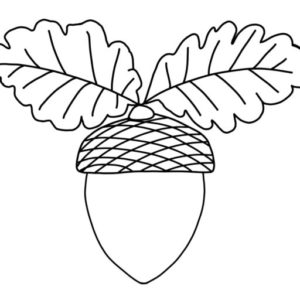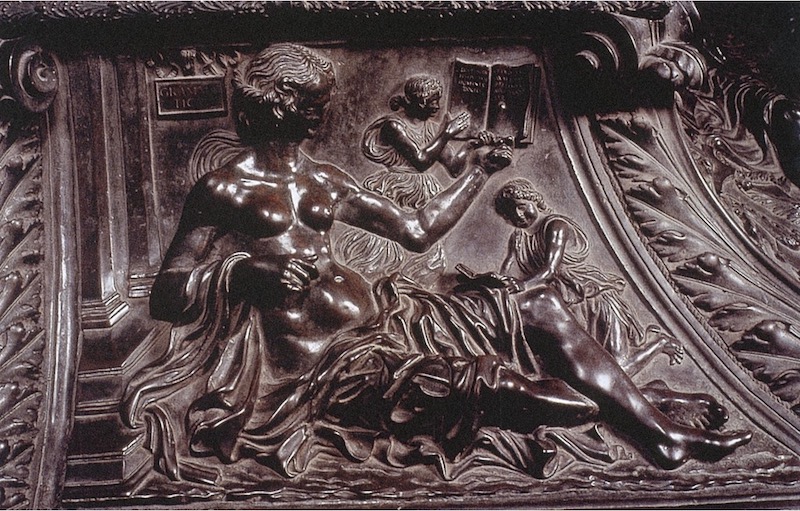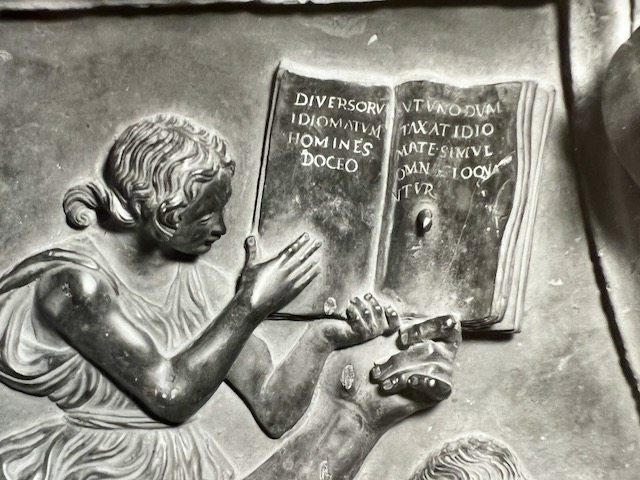Grammar
Also on the bottom of the tomb, near the pope’s feet, the figure of Grammatica (figure 21) allows for further identification of source texts that influenced Pollaiuolo’s design. This panel adds to the understanding of the ways in which Pollaiuolo diverges from the traditional symbolic associations of the Liberal Arts. In this panel, as previously mentioned, by visually mirroring the figures of Rhetorica and Grammar, Pollaiuolo connected the two base disciplines of Grammar and Rhetoric, suggesting that the two disciplines rely on each other to support their studies. The figure is identified as Grammatica from the plaque to her left. Lounging against a series of square columns on the left, her right arm is draped with the same cloth that covers her upper legs, yet this leaves her bare-breasted, while her left arm extends a book with an inscription on it (Figure 22). The inscription once again speaks to the viewer in Latin, writing “I inform men of various languages, so that all may speak one language.”[70] Purely invention without any direct source, her inscription utilizes the singular first-person, continued throughout the other inscriptions of the Trivium. However, this inscription has biblical connotations as it relates to the story of the Pentecost in which the apostles were able to communicate to the crowd despite all speaking different languages. She is seen with two smaller figures, one aiding in holding up the book with the inscription while the other figure kneels, resting a book with the first six letters of the alphabet against Grammar’s thigh. These two figures likely represent the children that Grammar would teach in early education.
Martianus Capella described Grammar, as dressed in a Roman-style cloak with a polished box. In the box was a pruning knife to “prune the faults of pronunciation in children” which was accompanied by a series of medicines capable of curing different issues that children have with pronunciation and spelling.[71] As Capella wrote, her dress was the “official dress of an orator or teacher.”[72] Notably, there is no allusion to oratory in this panel, however, since it is the subject of Rhetorica instead. In Pollaiuolo’s sculpture, however, she is shown as a teacher rather than an orator, likely connecting her to the children shown next to her. Consonant with Capella’s text, Grammar’s traditional iconography was that of a woman with a knife in one hand and a file in the other, with both instruments serving as a method to reduce errors in children’s speech. Alain de Lille also includes a knife, which served to create a tongue from wood.[73] Yet, she was also described as having breasts which were “swimming in an abundant torrent of milk, feigning the penalties of lost shame.”[74] In addition to the Tellus coin reference, this can contextualize the choice to depict her bare-breasted in the sculpture. Although neither of the children are breastfeeding, as described by Alain de Lille, the prominence of her breasts is nonetheless evident, especially in their materiality as the light shines and reflects off her chest. Pollaiuolo’s Grammar stresses the relationship with the discipline of Rhetoric through the visual reflection and adapts the iconography established in the textual sources by rendering a maternal figure, essential in young students’ study.
Figure 21. Antonio Pollaiuolo, Tomb of Sixtus IV, Detail of Grammar, c.1484-1493
Figure 22. Antonio Pollaiuolo, Tomb of Sixtus IV, Detail of Grammar Inscription, c.1484-1493


